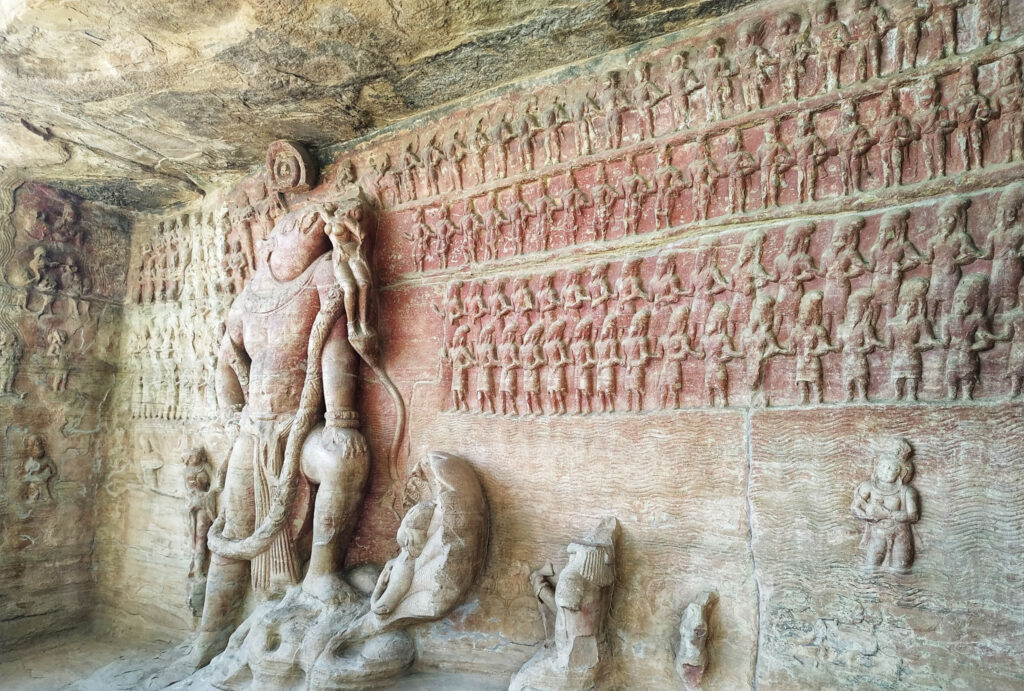
Credit: Pranav M
Overview and History
The Udayagiri Caves are a remarkable group of rock-cut caves that hold great historical and archaeological significance. India’s rich cultural heritage, the place is located approximately 7 km from Vishisha and 10 km from the Sanchi Railway station.
The literal meaning of Udayagiri is “sunrise mountain,” which has been sacred for both Buddhists and Hindus since the 2nd century BCE. It is also known as Vishnupadgiri, which literally means “the hill at the feet of Vishnu. Dating back to the early 5th century CE, caves are carved from rock and boast some of the oldest surviving Hindu temples and iconography in India. Adding to the allure, caves feature rock-cut water tanks and shrines.
Among the caves at Udayagiri, a number exhibit Hindu influence, including Vaishnavism, Shaktism, and Shaivism, while the rest are dedicated to Jainism. Jaina inscriptions dating back to 425 CE are inscribed in the Jain Cave. While the Hindu cave showcases an inscription from 401 CE. A false cave that is also known as the southernmost cave was added later. Located north of Cave 1, Cave 2 displays traces of two pilasters and reveals evidence of a structural mandapa beneath its roof.
Architectural Wonders
The first cave, Cave 3, is the first cave in the central group. The entrance to the sanctum is accompanied by a mandapa in front of the shrine, It exhibits a simple design. Inside the cave, you will find a rock-cut image of the war god Skanda. The next adjacent cave 4 is dedicated to Lord Shiva and boasts an impressive entrance flanked by the river goddesses Ganga and Yamuna. However, the most notable cave is Cave No. 5 which shelters the colossal Varaha panels. It depicts the third avatar of Lord Vishnu, a boar’s head, and a human that symbolize the divine rescue of the goddess Earth.
Adjacent to Cave 5, Cave 6 features a rock-cut sanctum that is guarded by a T-shaped door guarded by statues. Goddess Durga slaying Mahishasura and the seated figure of Lord Ganesha holding Modaks in his left hand. The next cave, Cave 7, is adorned with a number of figures depicting eight mother goddesses with weapons above their heads. In the shallow niches of the caves, there are figures of Kartikeya and Ganesh. A passage runs from east to west right after cave 7, resembling a cleft or canyon.
Cave 8, also known as “The Tawa Cave,“ houses a significant inscription, although it is considerably damaged. 4.5 feet caving on the ceiling is a remarkable feature. Caves 9,10. And 11 are small excavations located near Cave 8.
How to Reach
By Car:
Reaching Udayagiri Caves by car is a convenient option, allowing you to enjoy a scenic journey at your own pace. Here are the driving directions from major nearby cities:
From Vidisha: The caves are approximately 7 km away from Vidisha. Take the SH19 road towards Udayagiri village, and you’ll reach your destination in about 15 minutes.
From Bhopal: The distance between Bhopal and Udayagiri Caves is around 55 km. Take the NH86 route, which will lead you through Sanchi. From Sanchi, continue on the SH19 road until you reach Udayagiri village. The drive takes about 1.5 hours.
By Train:
If you prefer traveling by train, the Sanchi Railway Station is the nearest railway station to Udayagiri Caves. Here’s how you can reach Sanchi by train:
By Air:
If you prefer traveling by air, the nearest airport to Udayagiri Caves is the Raja Bhoj International Airport in Bhopal. Here’s how you can reach Bhopal by air:
